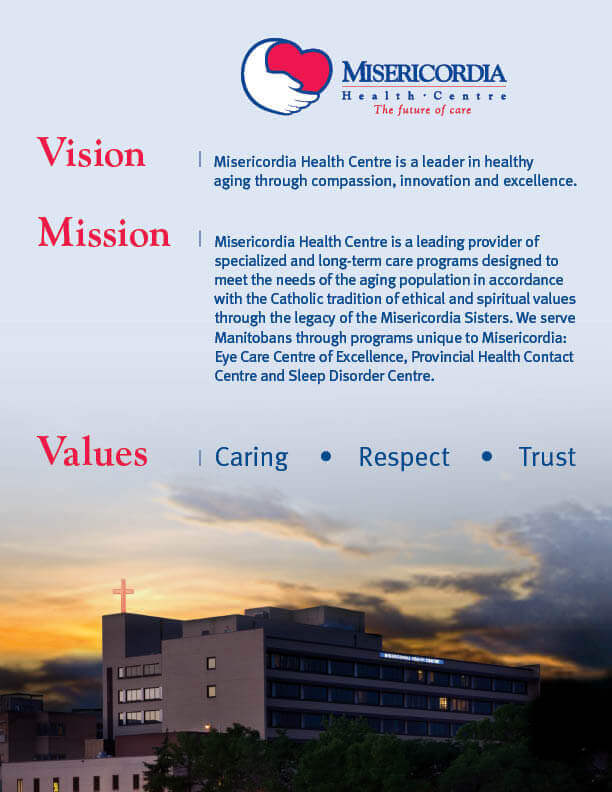Project Synopsis
May 2006 – March 2010
Background and Project Description
Vision impairment is one of the leading causes of lost independence among older adults. Visual deficits increase with age, leading to substantial changes in the older adult’s ability to manage activities of daily living. Research indicates that visual impairment is an independent risk factor for falls and fractures in this population group. It is known that falls and fractures can have devastating effects on the older adult with huge costs for the individual and the health-care system. A 2009 Access Economics report states that the cost of vision loss in Canada rates fourth in health care expenditures and is before diabetes, mental health issues and respiratory illnesses. A recent study published in the Canadian Medical Association Journal (2009) concluded that 25% of men or women, over the age of 50, who fracture a hip will die within 5 years of the fracture. The study suggests that given this association, interventions need to be implemented to reduce the likelihood that patients will experience fractures that will increase their risk of death. Estimates indicate that 20-50 percent of older people have undetected reduced vision, with the majority suffering from cataracts or refractive errors which are correctable. Residents who reside in the long- term care setting have 3.3 times greater amounts of visual deficits than the same group residing in the community setting. Currently Manitoba Health has no specific guidelines for vision care services in long-term care facilities. However, Manitoba is not unique. Globally, research indicates that seniors residing in long-term care settings are not receiving the vision care services they need. A survey conducted by S. Bell and P. Hawranik of long-term care facilities in Winnipeg and in Aberdeen, Scotland, revealed there is a lack of policy and minimal procedures in place to regularly vision screen long-term care residents upon admission or during the length of their residence in that facility.
This gap in service has been addressed at the Misericordia Health Centre (MHC) through a joint venture with Manitoba Health, as a three-year pilot project entitled: Focus on Falls Prevention. This is an innovative and unique patient safety project that has established itself as a pioneer in the area of vision care services as it relates to falls and associated fracture prevention. The project’s goal is to provide on-site vision care services to residents who reside in long-term care settings in the Province of Manitoba. Vision care services include: on-site vision screening with a reliable vision screening tool, on-site optometry services, appropriate referral, interventions, education and follow up for residents who reside in long-term care settings in the Province of Manitoba. The purpose of the project is to improve the quality of life and safety for seniors in the Province of Manitoba and to provide evidence that improving vision in this population group will impact positively on falls and fractures and demonstrate a more positive outcome on the overall health care budget and wait times.
The project consists of a vision history for each participant and on-site vision screening by a trained health-care professional. The on-site optometrist then examines the resident and, if warranted, refers appropriately. The project staff arrange for referrals, education to staff, residents and families, transportation to the eye care specialist and scheduling of any intervention that is recommended with appropriate follow up. Interventions can include and are not limited to: eye specific vitamins, new eye glass prescriptions, cataract surgery, eye drops, photodynamic therapy and avastin therapy, adequate lighting and magnifiers. The residents are followed up by each participating personal care home (PCH) to ensure the appropriate recommended interventions have been implemented. Since the project’s inception in 2006, over 900 residents have been assessed. Year One of the project was based at MHC and included residents at MHC as well as the St. James / Assiniboia Seniors Centre. In Year Two, the project moved to various PCH settings in the Winnipeg Regional Health Authority (WRHA). Year Three moved the project into other regions in the province of Manitoba as well as continuing with PCHs in the WRHA and community sites. Vancouver Coastal and Fraser Health regions in British Columbia have received training on vision screening and are incorporating this skill in their falls prevention strategies. They are anticipating that other regions in British Columbia will soon be joining this initiative. The project has received additional funding from Manitoba Health to continue for a fourth year. It is expected that the project will continue to move into other regions in the province as well as into acute and community settings and mobile falls assessment clinics in the WRHA.
Research
A research study (2006) to identify the prevalence of vision disorders at MHC, test the reliability of the vision-screening tool, and compare the prevalence of falls and associated fractures and various quality of life indicators was conducted on 92 MHC residents. The study consisted of a retrospective exploratory study with some pre and post measurements. A kappa score of .7 indicated a very high reliability of agreement between the use of the tool by the nurse and the optometrist assessment. The study data found that 74 of the 92 residents did not have a vision loss diagnosis at admission, however when screened, 72 of these 74 did have a vision disorder. In other words, 97.3 percent of the residents who were screened were found to have vision impairment, when previously there was no indication of vision impairment in their health record. Outcome evidence demonstrated that the group of seniors who had vision interventions did not have falls or fractures and improved their balance. Quality of life indicators including social engagement and depression also improved. The group of seniors who refused vision interventions had falls, fractures and deaths associated with fractures. They also demonstrated a decrease in balance, social engagement and an increase in depression. The two groups were similar for age, gender and levels of care. In the summer of 2009, 7 participating PCHs statistics were analyzed to compare outcomes with the original study. This analysis demonstrated parallel findings which support improving vision decreases the likelihood of falls and fractures. One participating region in Manitoba instituted vision screening in a PCH facility and saw an astounding 76% decrease in falls. The project continues to lobby funding resources for future research studies.
In the Province of Manitoba a regular eye examination for persons >65 costs approximately $70, cataract day surgery costs approximately $1400 and hip surgery with associated immediate rehabilitation, costs upwards of 60,000. The three falls with associated hip fractures (critical incidents) and associated deaths sustained during the study could possibly have been avoided if the residents had agreed to the recommended intervention of cataract surgery. This alone would have saved lives and the health-care budget of an estimated $180,000, not including the impact on resources related to the change in level of care and greater dependency on staff. Based on this evidence, it is apparent that by providing vision care services for residents who reside in the long- term care setting, falls and associated fractures deemed as critical incidents and possible deaths can be decreased and quality of life can be improved while positively impacting on the health-care budget and wait times.
The development of this project to a Provincial Patient Safety Program would provide a medically necessary service for our aging population. In May, 2010, the Focus on Falls Prevention Project was officially deemed a Program by Manitoba Health. Funding allows for the expansion of the program into LTC, Acute and Community care settings in the WRHA. Further funding is required to expand the program into all settings in all regions in the Province of Manitoba.
Project Leadership
Sandy Bell RN, BN, MN
Director Quality, Patient Safety and Education Services
Project Development and Executive Lead
Karen McCormac BN
Education Facilitator, Manager
Dr. Melina Chow
Optometrist
Research
Vision Care Services in Long-Term Care: A Feasibility Study
Primary Investigator
Pamela Hawranik, RN, BN, PhD
Associate Professor, Faculty of Nursing
Helen Glass Centre for Nursing
University of Manitoba, Winnipeg, MB, R3T 2N2
204-474-6716
Co-Investigator
Sandy Bell, RN, BN, MN
Director Quality, Patient Safety and Education Services
Misericordia Health Centre
99 Cornish Ave, Winnipeg, MB, R3C 1A2
204-788-8003
Stakeholders
- Canadian National Institute for the Blind
- Manitoba Association of Optometrists
- Manitoba Health
- Misericordia Health Centre
- Misericordia Health Centre Foundation
- Misericordia Health Centre Ophthalmology Clinic
- Osborne Spectacle Centre
- University of Manitoba

